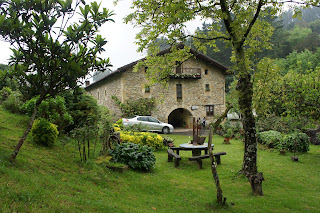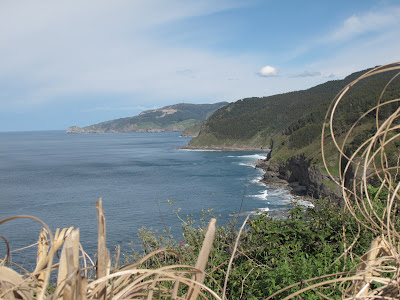Being Swiss, I felt almost at home while traveling through the Basque Countries. In fact, I found they were like a mini Switzerland on the ocean: a land of small towns and tiny villages spread all over the hills and valleys, clean and well organized. There aren't lakes but a breathtaking ocean coast instead!
The Basque Countries or Euskal Herria (in Basque language, so called Euskara - the oldest living language in Europe) is divided into three regions of which two, Autonomous Community of Euskadi and of Navarra (the Southern Basque), belong to Spain and the third one, Iparralde, is part of France. Nowadays the Euskal Herria is the definition of a cultural and historical entity with a language and an identity in common rather than a unified political country.
ToDo&Visit
 |
| San Sebastian |
ToSleep
The Basque Countries offer the amazing chance to overnight in the so called "casas rurales" (rural houses) which are basically private old houses. I found my accommodation on www.nekatur.net and I spent 2 nights by señora Maria Victoria in the village of Munitibar, about 22 km South-East from Guernica. In the nekatur website look for Garro, the name of the guesthouse. The place where I stayed was a gorgeous 200-years old house made of stone and wood which in the old days belonged to a powerful king of France. The married old lady señora Maria Victoria runs the business with about 5-6 double rooms and serves fresh home-made bread and pies in the morning for breakfast. Breakfast was an epic experience. It starts at 9h00 and all the guests of the house, if have requested breakfast, ate at the same big imperial table. It was actually funny to seat down next to the person you may think was the one snoring or coughing the night before in the room next to your one ;o) During breakfast I met some interesting people from Madrid, South of France, Catalonia and a nice funny couple: Claude from Senegal and Wojtek from Poland who are actually living around the corner from my current house in Barcelona... what an amazing coincidence!
ToEat&Drink
Pintxos are the typical Basque tapas (see pictures) which include a wide range of various type of finger foods. Usually pintxos are made of different ingredients placed on a slice of bread and some times kept together with a tooth-pick. Some of the combinations can be just divine! A typical local drink are the white txakoli wines or the apple cider. I haven't fancied much the local cider as the taste is rather sourish compared to the ones produced in Northern Europe, like for instance my favorite Magners! :oP
The Basque Countries offer the amazing chance to overnight in the so called "casas rurales" (rural houses) which are basically private old houses. I found my accommodation on www.nekatur.net and I spent 2 nights by señora Maria Victoria in the village of Munitibar, about 22 km South-East from Guernica. In the nekatur website look for Garro, the name of the guesthouse. The place where I stayed was a gorgeous 200-years old house made of stone and wood which in the old days belonged to a powerful king of France. The married old lady señora Maria Victoria runs the business with about 5-6 double rooms and serves fresh home-made bread and pies in the morning for breakfast. Breakfast was an epic experience. It starts at 9h00 and all the guests of the house, if have requested breakfast, ate at the same big imperial table. It was actually funny to seat down next to the person you may think was the one snoring or coughing the night before in the room next to your one ;o) During breakfast I met some interesting people from Madrid, South of France, Catalonia and a nice funny couple: Claude from Senegal and Wojtek from Poland who are actually living around the corner from my current house in Barcelona... what an amazing coincidence!
 |
| Rural House in Munitibar by señora Maria Victoria |
Pintxos are the typical Basque tapas (see pictures) which include a wide range of various type of finger foods. Usually pintxos are made of different ingredients placed on a slice of bread and some times kept together with a tooth-pick. Some of the combinations can be just divine! A typical local drink are the white txakoli wines or the apple cider. I haven't fancied much the local cider as the taste is rather sourish compared to the ones produced in Northern Europe, like for instance my favorite Magners! :oP
 |
| Pintxos |
- Renting a car is a must, otherwise you would miss out of the most beautiful scenery that only with the independency of having your own vehicle offers
- Visit the unusual Guggenheim museum in Bilbao
- Wonder around the backstreets of the old city center of San Sebastian and let your self bounce from one Taberna to the next one to taste the endless variety of pintxos. One of the main street with restaurants is 31 de Agosto Kalea

No comments:
Post a Comment